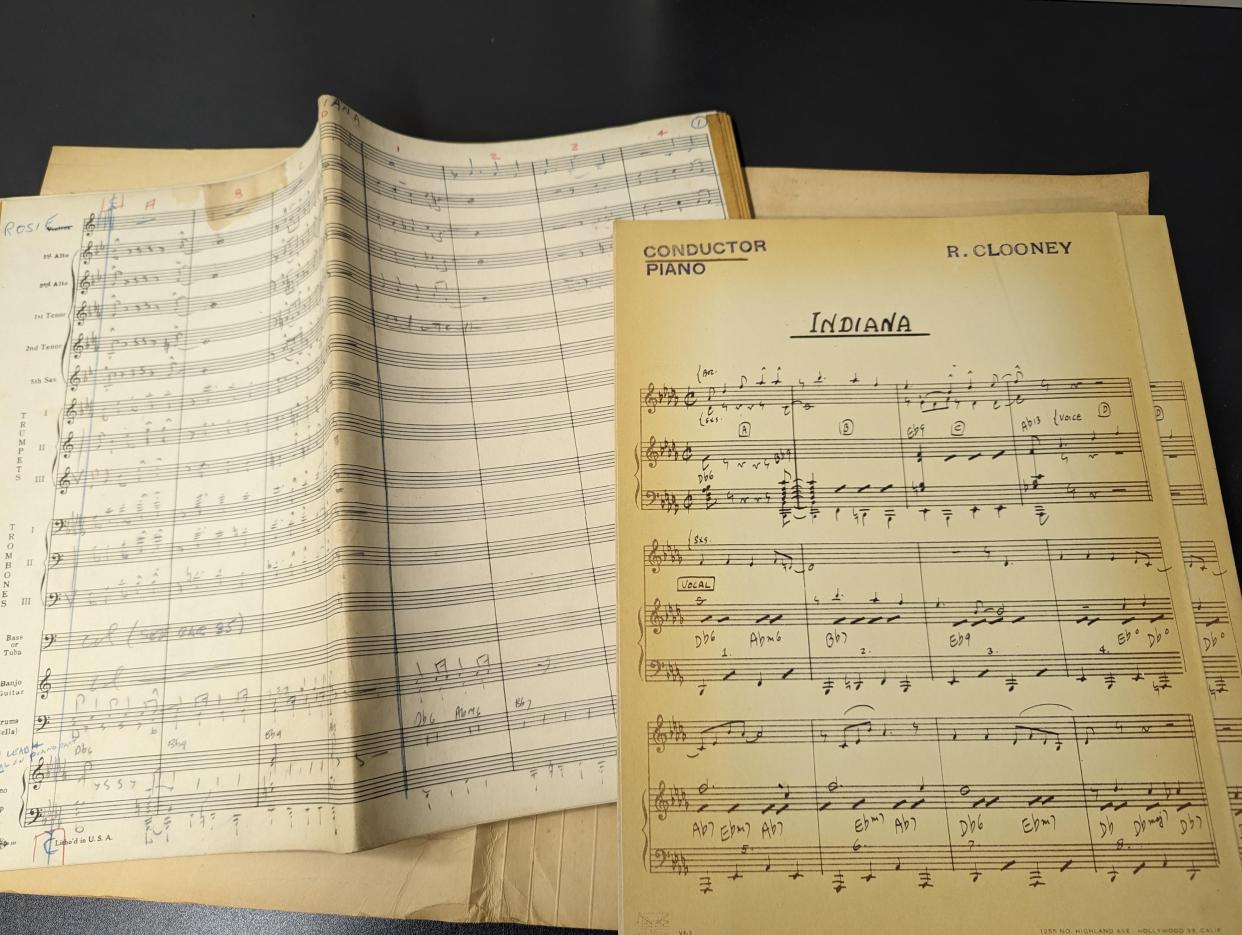Before "Back Home Again" became an Indy 500 icon, this author called it 'a direct steal'
In 1946, opera star James Melton delivered 56 soaring seconds of "(Back Home Again in) Indiana," his clear and full-bodied tenor silencing thousands of chattering race fans who were about to see the first Indianapolis 500 since the U.S. had entered World War II. His performance was intended to commemorate the event's return, but its popularity enshrined it as a cherished part of the pre-race festivities.
Just six years before, however, an accusation of intellectual theft could have derailed the historic moment — or, at the very least, vastly altered it. Author Theodore Dreiser claimed that "Indiana," composed in 1917, drew too heavily on the lyrics and music from his brother's 1897 song "On the Banks of the Wabash, Far Away," and he demanded that some of its best-known passages be removed. Even today, many recognize the similarities and see the second song as an homage to the first.
"They both hearken to the past and to family and home and place," said Chris Lewis, executive director of the Great American Songbook Foundation in Carmel.
In the end, of course, Dreiser, who became well-known for writing "Sister Carrie" and "An American Tragedy," did not get his way, and the signature tune of "Indiana" has become synonymous with the Indy 500.
But Dreiser's dogged pursuit of the copyright complaint — and his possible reasons for doing so — illustrate a quirky, little-known story in the history of Hoosiers' favorite song and the once-beloved inspiration it eventually surpassed in fame.
Recent 500 news: IMS says 2024 Indy 500 ticket sales more than 15,000 ahead of 2023, complete sellout unlikely
How the songs came into being
At its height at the turn of the last century, the strains of "On the Banks of the Wabash" rang out all over the nation. People heard it performed in music halls and restaurants, hummed in streetcars, whistled en masse when the lights went out at a Coney Island prize fight, cranked by organ-grinders on the street.
"It's just so beautiful, and it's so sentimental," said Brent Wallarab, who teaches jazz studies at Indiana University and arranges and conducts the American Pianists Awards' jazz piano final concert.

Terre Haute-born hitmaker Paul Dresser — who changed his last name for an easier-to-pronounce, show-business version — composed the song. Over the course of his life, he rode the high of Broadway and Tin Pan Alley fame and the low of poverty due to his lack of business acumen and often boundless generosity, according to Clayton Henderson, who chronicled "Wabash's" popularity and copyright dispute in the biography, "On the Banks of the Wabash: The Life and Music of Paul Dresser."
The work lived on after its creator died at age 47 in 1906, and "Wabash" became Indiana's state song in 1913. From there, it remained beloved — so much so that in 1917, Rensselaer native James F. Hanley, who would later deliver hits on Broadway and in Hollywood, and his lyricist partner Ballard MacDonald, who wrote the lyrics to Ohio's state song, penned what many think they meant as an homage.
The duo initially named their Hoosier tune "Indiana," but its stirring opening line has lengthened its colloquial title over the years. The song became a fixture of patriotic concerts during World War I and was first performed at the Indy 500 in 1919. People outside of Indiana still know it today as a jazz standard thanks to celebrated performances by the Original Dixieland Jazz Band, Red Nichols, Louis Armstrong, Bud Powell and more.
"There's sort of a perfect combination of lyrics and music," Lewis said. "When you think of a song like "(Back Home Again in) Indiana," you can't hear that first phrase without hearing the words in your head."
"Indiana" and "Wabash" would co-exist peacefully for more than 20 years — until, as Henderson wrote, a 1939 romantic comedy caught the attention of Dresser's younger brother.
'A direct steal on my brother's song'
Not only is the melody of "Indiana" threaded throughout the score of "Remember the Night," then-famous radio star Martha Mears appears on screen to croon it as co-stars Fred MacMurray and Barbara Stanwyck share their first dance at a swanky restaurant.
"Indiana's" mood, its chorus, its imagery of moonlight and new mown hay and gleaming candlelight — they all struck Dreiser as too familiar. In a letter to his lawyer, he called the ballad "a direct steal on my brother's song." Dreiser and his wife debated the issue with his lawyer and the president of Paull-Pioneer Music Corp., which then held the copyright to "Wabash," for much of 1940.
"I, as executor for the Paul Dresser estate, must ask that the words and music from 'The Banks Of The Wabash' be deleted from the song, 'Indiana' as it is now published," Dreiser wrote to Paull-Pioneer in an August 1940 letter attempting to persuade the company to pursue his cause. The correspondence regarding the two songs is now held in the University of Pennsylvania Libraries' Theodore Dreiser Collection.
"Indiana" might not have come to Dreiser's attention earlier since he was pursuing his own career and sorting out Dresser's complex estate, Henderson wrote. When it did, Dreiser might have had his own motives for pursuing a complaint. The author claimed he came up with "Wabash's" subject and even wrote some of its lyrics. Given that Dresser never mentioned this, scholars have long argued over how much of Dreiser's assertion is true.
But the two brothers were personally close, even though they were separated by more than 13 years. After he left home, Dresser returned to Indiana repeatedly to lavish gifts upon his poverty-stricken family, and he supported his psychologically crushed brother after the initial critical failure of "Sister Carrie" in 1900, said Jerome Loving, author of the Dreiser biography "The Last Titan."
"I think Dreiser might have objected to his own writing ... being taken away," Loving said. "Though I think he would probably speak more on behalf of Paul, whom he loved very much."
Decades after his older brother's death, Dreiser worked on projects to honor him, including the 1942 biopic "My Gal Sal," which pulled its title from one of the late songwriter's biggest hits.
The situation resolved with an unhappy Dreiser
Not long after he began to pursue a copyright complaint in 1940, Dreiser found that much stood in the way of removing the parts of "Indiana" he felt were stolen.
Paull-Pioneer President Max Mayer informed Dreiser in a return letter that a music company that owned "Wabash's" copyright before Paull-Pioneer acquired it had given Hanley and MacDonald permission to use two bars of music. The permission is noted on the sheet music as well.
Such a move wasn't unusual.
"Figuring out how to maximize profits and how to maximize treating the music as a commodity was something that was really starting to take shape at this time," said Kathleen DeLaurenti, director of the Arthur Friedheim Library at the Peabody Institute of the Johns Hopkins University.
Starting in the 1920s, some publications of "Wabash" did not contain the original 1897 copyright notice in an attempt to make the song seem more contemporary, Mayer surmised in a letter to Dreiser. That meant the song's copyright protection had been forfeited, DeLaurenti said.
Given all these factors, Mayer informed Dreiser that Paull-Pioneer had no interest in suing "Indiana" publisher Shapiro, Bernstein and Co., who had declined to remove the phrases in question.
An uneasy resolution came when Shapiro, Bernstein and Co. in an attempt to mollify Dreiser offered $200 — about $4,400 in today's money.
"I'd like to add that the 'Indiana' song of Shapiro, Bernstein's is not a big seller and it certainly cannot hurt "WABASH," wrote Mayer, who urged Dreiser to take what he called "found money."
The author refused, but Mayer accepted the sum and sent it to Dreiser anyway.
"The 'Indiana' team would have come out victorious in any way," DeLaurenti said. "The comments about Indiana not generating much income and the payment are amusingly incongruent. (Shapiro, Bernstein and Co.) clearly wanted to avoid some bad press."
The songs' relationship isn't uncommon
Music history abounds with compositions that quote predecessors. For example, classical composers frequently borrowed passages, not because they lacked ideas but because they knew audiences would recognize them as an homage to previous masters, Wallarab said. He sees the same dynamic in the relationship between "Wabash" and "Indiana."
But why one song surpassed the other could have a few answers. The musical form of "Wabash" is more complicated, Wallarab said, whereas "Indiana" is easier to learn and has chord changes beloved by bebop musicians who repurposed them in popular tunes like "Donna Lee."
"To your young jazz musician who was coming up in the 1920s, they were probably looking at that — you know, Stephen Foster and that second half of the 19th century, that kind of American popular music — they probably looked at ("On the Banks of the Wabash") as old and old-fashioned," Wallarab said.
"Something like '(Back Home Again in) Indiana,' it felt new, it felt fresh, so they're going to gravitate toward that."

These days, those who know "Wabash" well have likely made the effort to seek it out. That the work has survived this long makes it a good candidate for the Great American Songbook, too, Lewis said.
"Indiana," of course, has a firm grip on a loftier distinction in the canon of songs that have transcended their time. Its annual appearance just before the race — and shortly after Irving Berlin's iconic "God Bless America" — fascinates Lewis at every Indy 500.
"It's like the greatest number of people singing songbook songs that probably exists anywhere," he said.
An Indy 500 tradition: The surprising history of '(Back Home Again in) Indiana' & everyone who sang it
112-year-old mystery solved? Indiana madam may have inspired famous song 'My Gal Sal'
Looking for things to do?Our newsletter has the best concerts, art, shows and more — and the stories behind them
Contact IndyStar reporter Domenica Bongiovanni at 317-444-7339 or d.bongiovanni@indystar.com. Follow her on Facebook, Instagram or Twitter: @domenicareports.
This article originally appeared on Indianapolis Star: Why an author called 'Back Home Again in Indiana' 'a direct steal'
